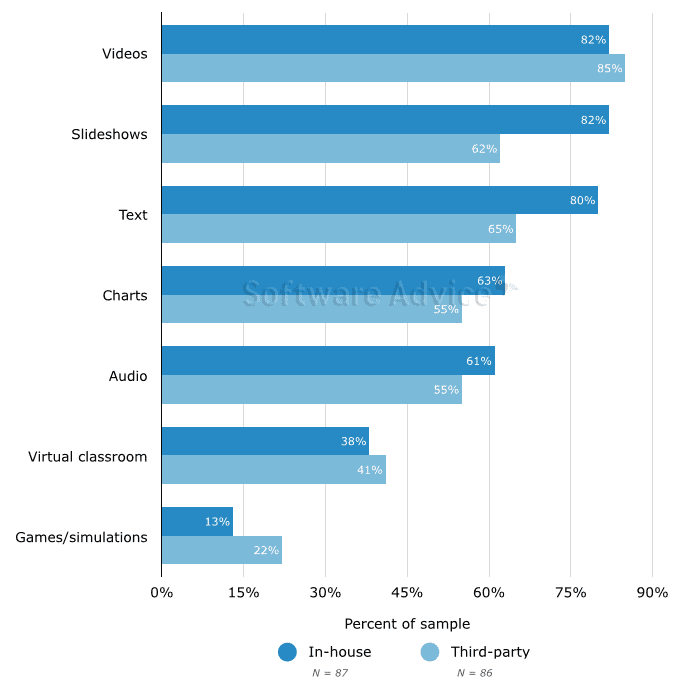Do you sell or create courses and/or training online? If yes, then chances are you are using a learning management system (LMS) to do so. An LMS is a great tool for delivering your online content and well as tracking, reporting, and administering.
There are numerous ways to create your eLearning content that is uploaded and delivered via your LMS. Do you create the courses and training on your own or do you look for a third-party source?
DigitalChalk recently participated in a Software Advice survey of 150 LMS administrators on the use of third-party vs. in-house training materials. See the results below.
73% of LMS users use a mix of both in-house and third-party training content. Using a combination of in-house and third-party is also the most effective way for employees to retain information.
Video is the most popular format for training content with 82% creating videos in-house and 85% from a third-party. Slideshows and text are also common content types.
In-house content is used primarily when training materials need to be company-specific; third-party content is widely used for generic training.
There are many pros and cons to each. For example, in-house content gives you creative control and editing ability – and third-party can be less costly and available immediately.
3 Best Practices For You
Use both in-house and third-party content.
By combining both of these, you can take advantage of the benefits of each. In-House content allows for greater flexibility, control and can ultimately be sold to others if you desire. Third-party content is less costly, widely available and you gain a helpful outside perspective.
Video training is most effective.
Video is the most popular format for training content, and short-form video, specifically, is the most effective. There are many affordable editing and screen-capturing tools that make it easy to create videos.
Create company-specific content and use third-parties for the rest.
Any training that may need specific internal company knowledge and information is best to be created in-house. If the training is more general and basic, you can easily look to third-party sources to help.
How Does DigitalChalk Fit In?
DigitalChalk’s LMS is easy to use and if you have any trouble getting started, there are many online resources and tutorials to walk you through it. That being said, you can upload and create your content easily in-house or you can have a third-party source create and upload for you. With DigitalChalk’s different “course elements”, you have the ability to really create a well-rounded course in just a few steps.
With video being the most popular form of online content, we can easily use the “Chalkboard” element to upload your video seamlessly. Are you looking to add slideshows as well? You can upload your slideshows directly within the same “Chalkboard” element or use the simple “PPT Converter” element for even less work.
Whether you are creating your training content in-house or through a third-party, DigitalChalk will still be a perfect fit.
Commentary
“While learning management systems (LMS) are great tools to administer employee training, they don’t create content out of thin air. So companies have two choices: they can either create training content in-house or use premade training content from third-party sources like YouTube or OpenSesame. With training costs per employee rising over the past eight years, it’s more important than ever that companies find the best content for their dollar.
To find out which content is best for different training purposes, Software Advice, a company that offers compares LMS platforms, surveyed nearly 100 corporate LMS administrators to find out what content that they use and how effective it makes their company’s training.
Not surprisingly, 73 percent of our respondents use a mix of in-house and third-party training content in their LMS software. This is definitely a best practice, as it allows companies to get the maximum benefit from each. In-house content is easily editable, allows for maximum creative control and can even be sold to others on learning marketplaces for profit. On the flip side, third-party content brings in outside expertise, is less costly and is immediately available for use.
Respondents using a combination of in-house and third-party training content are also most likely to say trainees retain information in an “extremely effective” manner, reinforcing that this is the best route for companies to take.
We also asked respondents what formats of training content they use. For both in-house (82 percent) and third-party training content (85 percent), videos are the most popular format. Short-form video has emerged as the ideal way to train employees, and companies have a number of options to either create videos (through video editing programs like Adobe Premiere) or find videos online (YouTube, Lynda.com) for different training purposes. If companies are really having trouble creating or finding content, LMS vendors are a great resource for assistance.
Regardless of what formats of content are used for training, most LMS systems allow users to combine formats as learning objects in whatever order they please to create a full training course for employees.
Finally, we wanted to know why companies decide to create training content or borrow it from other sources. Those that create in-house training content most often say it’s to make the content company-specific (53 percent), while those that use third-party content say it’s because the training need is basic/generic (26 percent). This use of in-house content for specific, internal knowledge and third-party content for generic training needs correlates with our other finding that in-house training is most commonly used for purposes like job-specific training (79 percent) while third-party content is most commonly used for purposes like compliance training (58 percent).
Ideally, companies should first create training content to instill company ideals, knowledge and best practices. Then, third-party content can be used to fill training gaps for things like sexual harassment training or training on how to use a specific software program.
We learned a lot in our findings on LMS training content. First, that companies should use a mix of in-house and third-party content in their training for maximum effectiveness. Second, that short-form video is the best format to use, and that a number of cost-effective tools have made it easier than ever for companies to make their own videos. And finally, that content should be created in-house for specific, internal company knowledge and that third-party content can fill any remaining generic training gaps. Using these best practices, corporate LMS users should be able to put together effective training courses to engage employees.” -Brian Westfall, Market Research Associate
All data courtesy of Software Advice.





0 Comments